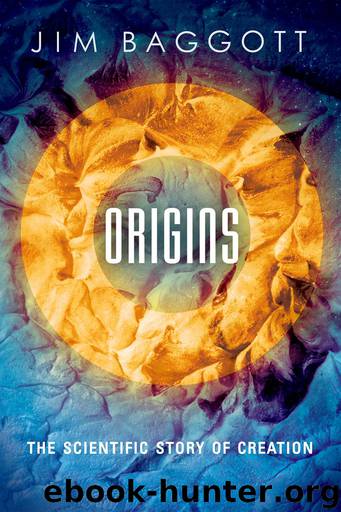Origins by Baggott Jim;

Author:Baggott, Jim;
Language: eng
Format: epub
Publisher: Oxford University Press
Published: 2015-08-23T16:00:00+00:00
LIFE’S BUILDING BLOCKS
Despite the extraordinary diversity of life on Earth today, all life forms rely on broadly the same set of cellular structures and biochemical systems that are used to acquire energy, metabolize, grow, and replicate. Underpinning these fundamental biological processes is a set of bio-molecular mechanisms that are involved in (among other things) capturing, transferring, and storing energy and holding, transferring, and replicating what we have learned to think of as genetic information that specifies what kind of life it is.
In an attempt to keep things reasonably simple, I’m going to focus on two types of fundamental building blocks. These are chemicals called amino acids, the constituents of proteins, and nucleotides, involved in the complex molecular structures that carry genetic information and which code for the construction of proteins.
We’ll begin with amino acids. These form a class of chemical compounds which consist of two functional groups, an amine group (—NH2, hence ‘amino’) and a carboxylic acid group (—CO2H, hence ‘acid’). These compounds are distinguished from each other by possession of a third group which forms a side-chain, usually given the generic symbol ‘R’. With some exceptions, we can write a general formula for amino acids as H2N—CHR—CO2H.
There are about 500 known amino acids, but there is a core of just 20 that are intimately involved in biological systems.* These can be further categorized according to the nature of their side-chains, and a breakdown is provided in Figure 58.4
Download
This site does not store any files on its server. We only index and link to content provided by other sites. Please contact the content providers to delete copyright contents if any and email us, we'll remove relevant links or contents immediately.
Sapiens: A Brief History of Humankind by Yuval Noah Harari(13933)
Sapiens by Yuval Noah Harari(5100)
Homo Deus: A Brief History of Tomorrow by Yuval Noah Harari(4662)
Pale Blue Dot by Carl Sagan(4586)
Livewired by David Eagleman(3518)
Origin Story: A Big History of Everything by David Christian(3456)
Brief Answers to the Big Questions by Stephen Hawking(3225)
Inferior by Angela Saini(3134)
Origin Story by David Christian(2972)
The Gene: An Intimate History by Siddhartha Mukherjee(2903)
Signature in the Cell: DNA and the Evidence for Intelligent Design by Stephen C. Meyer(2861)
The Evolution of Beauty by Richard O. Prum(2854)
Aliens by Jim Al-Khalili(2685)
How The Mind Works by Steven Pinker(2600)
A Short History of Nearly Everything by Bryson Bill(2493)
Sex at Dawn: The Prehistoric Origins of Modern Sexuality by Ryan Christopher(2399)
From Bacteria to Bach and Back by Daniel C. Dennett(2379)
Endless Forms Most Beautiful by Sean B. Carroll(2339)
Who We Are and How We Got Here by David Reich(2327)
